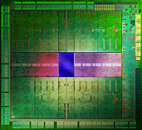- Joined
- Oct 9, 2007
- Messages
- 47,612 (7.45/day)
- Location
- Dublin, Ireland
| System Name | RBMK-1000 |
|---|---|
| Processor | AMD Ryzen 7 5700G |
| Motherboard | Gigabyte B550 AORUS Elite V2 |
| Cooling | DeepCool Gammax L240 V2 |
| Memory | 2x 16GB DDR4-3200 |
| Video Card(s) | Galax RTX 4070 Ti EX |
| Storage | Samsung 990 1TB |
| Display(s) | BenQ 1440p 60 Hz 27-inch |
| Case | Corsair Carbide 100R |
| Audio Device(s) | ASUS SupremeFX S1220A |
| Power Supply | Cooler Master MWE Gold 650W |
| Mouse | ASUS ROG Strix Impact |
| Keyboard | Gamdias Hermes E2 |
| Software | Windows 11 Pro |
Although NVIDIA's Tegra line of SoCs are among the best performing there are on the market; the high-end SoC market is dominated by Qualcomm and Samsung. These chips are built from scratch by the companies, but the underlying CPU and GPU architectures are licensed from ARM, and the likes of Imagination Technologies, respectively. Imagination's PowerVR graphics cores make up over 80 percent of the embedded GPU market-share. There's a big change of plans at NVIDIA. The company is beginning to think that its expertise in GPU is better proliferated in the mobile SoC space not by waiting for Tegra to gain a foothold, but by licencing its GPU IP (intellectual property) to whoever is willing pay up, much in the same way ARM and Imagination do.
NVIDIA spokesperson David Shannon, in a recent blog post, wrote: "our next step is to license our GPU cores and visual computing patent portfolio to device manufacturers to serve the needs of a large piece of the market... We'll start by licensing the GPU core based on the NVIDIA Kepler architecture, the world's most advanced, most efficient GPU. Its DX11, OpenGL 4.3, and GPGPU capabilities, along with vastly superior performance and efficiency, create a new class of licensable GPU cores. Through our efforts designing Tegra into mobile devices, we've gained valuable experience designing for the smallest power envelopes. As a result, Kepler can operate in a half-watt power envelope, making it scalable from smartphones to supercomputers."

View at TechPowerUp Main Site
NVIDIA spokesperson David Shannon, in a recent blog post, wrote: "our next step is to license our GPU cores and visual computing patent portfolio to device manufacturers to serve the needs of a large piece of the market... We'll start by licensing the GPU core based on the NVIDIA Kepler architecture, the world's most advanced, most efficient GPU. Its DX11, OpenGL 4.3, and GPGPU capabilities, along with vastly superior performance and efficiency, create a new class of licensable GPU cores. Through our efforts designing Tegra into mobile devices, we've gained valuable experience designing for the smallest power envelopes. As a result, Kepler can operate in a half-watt power envelope, making it scalable from smartphones to supercomputers."

View at TechPowerUp Main Site











